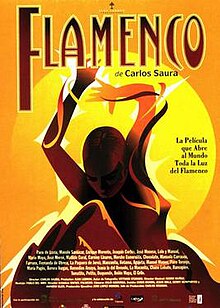
Flamenco is an art form based on the various folkloric music traditions of southern Spain, developed within the gitano subculture of the region of Andalusia, and also having historical presence in Extremadura and Murcia. In a wider sense, the term is used to refer to a variety of both contemporary and traditional musical styles typical of southern Spain. Flamenco is closely associated to the gitanos of the Romani ethnicity who have contributed significantly to its origination and professionalization. However, its style is uniquely Andalusian and flamenco artists have historically included Spaniards of both gitano and non-gitano heritage.
Some films feature recognizable dance forms, demonstrating them, shedding light on their origin, or being the base of a plot.

Siguiriyas are a form of flamenco music in the cante jondo category. This deep, expressive style is among the most important in flamenco. Unlike other palos of flamenco, siguiriyas stands out for being purely Romani (Calé) in origin. Siguiriyas are normally played in the key of A Phrygian with each measure consisting of 12 counts with emphasis on the 1st, 3rd, 5th, 8th and 11th beats as shown here:

Joaquín Pedraja Reyes is a Spanish classically trained ballet and flamenco dancer.
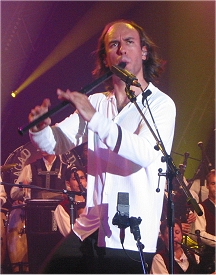
Carlos Núñez Muñoz is a Spanish musician and multi-instrumentalist who plays the gaita, the traditional Galician bagpipe, Galician flute, ocarina, Irish flute, whistle and low whistle.
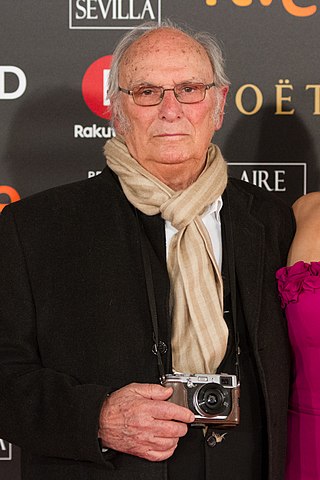
Carlos Saura Atarés was a Spanish film director, photographer and writer. With Luis Buñuel and Pedro Almodóvar, he is considered to be among Spain's great filmmakers. He had a long and prolific career that spanned over half a century, and his films won many international awards.

Tango is a 1998 Argentine-Spanish musical drama film written and directed by Carlos Saura and starring Miguel Ángel Solá and Mía Maestro. It was photographed by cinematographer Vittorio Storaro.

Sara Pereyra Baras is a Spanish flamenco dancer and choreographer born in San Fernando (Cádiz) who has established her own dance company.
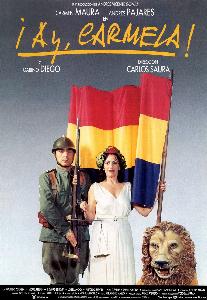
¡Ay, Carmela! is a 1990 Spanish comedy-drama film directed by Carlos Saura and based on the eponymous play by José Sanchís Sinisterra. The film stars Carmen Maura, Andrés Pajares, and Gabino Diego as travelling players performing for the Republic, who inadvertently find themselves on the nationalist side during the closing months of the Spanish Civil War. The film was selected as the Spanish entry for the Best Foreign Language Film at the 63rd Academy Awards, but was not accepted as a nominee.

Cristina Hoyos Panadero is a Spanish flamenco dancer, choreographer and actress, born in Seville, Spain. After a successful worldwide career, she opened her own dance company in 1988 that premiered at the Rex Theatre in Paris. She played an important role during the opening and closing ceremonies of the 1992 Summer Olympics in Barcelona.

El amor brujo or Carlos Saura Dance Trilogy, Part 3: El Amor Brujo is a 1986 Spanish musical film written and directed by Carlos Saura. It was directed and choreographed in the flamenco style by Maria Pagès. It is the third part of the Saura's flamenco trilogy he made in the 1980s, after Bodas de sangre in 1981 and Carmen in 1983. The film was screened out of competition at the 1986 Cannes Film Festival.

Goya en Burdeos is a 1999 Spanish historical drama film written and directed by Carlos Saura about the life of Francisco Goya, the Spanish painter.

Vittorio Storaro is an Italian cinematographer and a member of both the Italian Society of Cinematographers (AIC) and the American Society of Cinematographers (ASC). Storaro's early films were made in his homeland of Italy, where he began early collaborations with Italian director Bernardo Bertolucci, with whom he has continued to collaborate with throughout his career. Storaro and Bertolucci's first major project was the 1970 film The Conformist, based on the Italian novel of the same name.

Lole y Manuel was a gitano musical duo formed by singer Dolores Montoya Rodríguez (1954-) and guitarist Manuel Molina Jiménez (1948-2015). They composed and performed innovative flamenco music between 1972 and 1993.

María Jesús Pagés Madrigal, better known as María Pagés, is a modern Spanish dancer and choreographer and one of the most internationally renowned Flamenco artists in the world. She is considered the paramount representative of flamenco vanguard. Internationally acclaimed for her personal aesthetic concept of this dance, she has proven to be the leading pioneer in the understanding of this art as an evolution, contemporary and alive, making her a leading innovator of modern flamenco. She founded her own dance company in 1990, now based in Madrid, Spain, while performing worldwide. In 2014 she was awarded with the Gold Medal of Merit in the Fine Arts (Spain) by the Spanish State through the Ministry of Culture.
J: Beyond Flamenco is a 2016 Spanish musical film directed by Carlos Saura. It was selected to be screened in the Masters section at the 2016 Toronto International Film Festival.
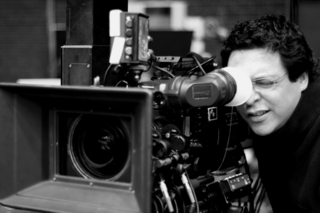
Leslie Calvo is a Spanish film producer and director. He was an executive producer of musical films by Spanish director Carlos Saura.
Antonio Gómez de los Reyes known as Antonio Canales is a male flamenco dancer and choreographer born in Seville.

Belén Maya is a Spanish flamenco dancer, choreographer and educator.
The King of All the World is a 2021 musical drama film directed and written by Carlos Saura. A Mexico-Spain co-production, the cast is led by Ana de la Reguera, Manuel García Rulfo, Damián Alcázar, Enrique Arce, Manolo Cardona, Isaac Hernández and Greta Elizondo.
